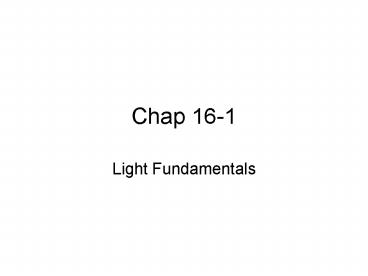Chap 16-1 - PowerPoint PPT Presentation
Title:
Chap 16-1
Description:
Chap 16-1 Light Fundamentals What is Light? A transverse electromagnetic wave What is Light? A small part of the electromagnetic spectrum The part which stimulates ... – PowerPoint PPT presentation
Number of Views:78
Avg rating:3.0/5.0
Title: Chap 16-1
1
Chap 16-1
- Light Fundamentals
2
What is Light?
- A transverse electromagnetic wave
3
What is Light?
- A small part of the electromagnetic spectrum
- The part which stimulates the retina of the human
eye - Visible light has wavelengths 400-700 nm
RED Longer ? Lower f Lower E
BLUE Shorter ? Higher f Higher E
4
How does light interact with matter?
- Light does not require matter (no medium) for
transmission - BUT if light does pass through matter
- Light travels in a straight line through a
- Vacuum or a
- Uniform medium
5
Ray Model
- A ray is a straight line that represents the path
of a narrow beam of light - ignores the wave nature of light
- a useful model in analyzing reflection and
refraction (ray diagrams)
6
Speed of Light
- Before 17th century light thought to be
instantaneous - Galileo thought speed of light was finite but
could not measure it - Ole Roemer (1700)
- through measurements of the period of Io, a moon
of Jupiter, - Calculated that light took 22 min to cross the
diameter of Earths orbit - Calculated speed of light at 2.2 x 108 m/s (75
of true value)
7
Roemers Method for calculating the speed of
light
http//en.wikipedia.org/wiki/Speed_of_lightEarly_
attempts
In 1675, the Danish astronomer Ole Roemer
noticed, while observing Jupiter's moons, that
the times of the eclipses of the moons of Jupiter
seemed to depend on the relative positions of
Jupiter and Earth. If Earth was close to Jupiter,
the orbits of her moons appeared to speed up. If
Earth was far from Jupiter, they seemed to slow
down. Reasoning that the moons orbital
velocities should not be affected by their
separation, he deduced that the apparent change
must be due to the extra time for light to travel
when Earth was more distant from Jupiter. Using
the commonly accepted value for the diameter of
the Earth's orbit, he came to the conclusion that
light must have traveled at 200,000 Km/s. This
is 75 of the accepted value.
8
Albert Michelson
- Michelson (1926) made a more precise measurement
for speed of light, c with the Michelson-Morely
Experiment
9
Michelson
- Won the Nobel Prize
- Successfully measured the speed of light
- c 3.00 x 108 m/s in a vacuum
- this is a defined value for light
- Now objects lengths are determined by how long it
takes for light to travel from one end to the
other - Examples
- Definition of the meter
- Light year
10
Sources of Light
- A luminous body emits light waves.
- An illuminated body reflects light waves produced
by an outside source. - Incandescent light produced by a hot body.
11
Luminous Flux
- The rate at which visible light is emitted by a
source - Represented by the letter P
- The unit is the lumen, abbreviated lm
- A typical 100 W light bulb emits 1750 lm
12
Illuminance
- The rate at which light falls on a surface
- Represented by the letter E
- The unit is lumens per square meter,
- lm/m2 lux, abbreviated lx
13
Consider a 100-W light bulb in the middle of a
sphere. What is the illumination (illuminance)
of the sphere?
14
Note that illumination is proportional to
1/r2 Inverse-Square Relationship Light from a
point source spreads out over an area
proportional to the square of the distance from
the source
15
(No Transcript)
16
Luminous Intensity
- the luminous flux that falls on 1 m2 of a sphere
1m in radius. - Unit candela, cd which is the SI unit of light
intensity. - Luminous Intensity P/4 p
17
- A lamp is moved from 30 cm to 90 cm above the
pages of a - book. Compare the illumination on the book
before and after - the lamp is moved.
18
7. What is the illumination on a surface 3.0 m
below a 150 Watt incandescent lamp that emits a
luminous flux of 2275 lm?
19
- A 64 cd point souce of light is 3.0 m above the
surface - of a desk. Wht is the illumination on the desks
surface in lux?
20
- The illumination on a tabletop is 20 lx. The lamp
providing - the illumination is 4.0 m above the table.
- What is the intensity of the lamp?
21
- A public school law requires a minimum
illumination of - 160 lx on the surface of each students desk. An
architects - specifications call for classroom lights to be
located 2.0 m - above the desks. What is the minimum luminous
flux the - lights must deliver?
22
End 16-1































